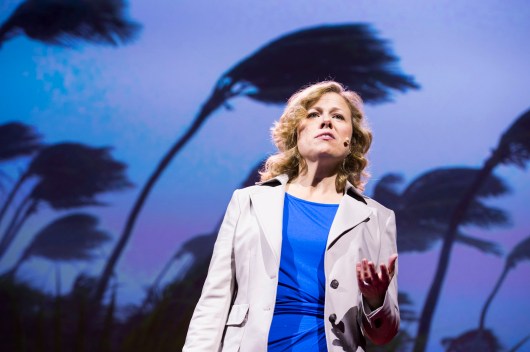Vicki Arroyo knows a thing or two about climate change. A lawyer by training, she is the executive director of the Georgetown Climate Center, which works on policies to help government leaders (and the world) deal with climate change’s inevitable disruptions. But that’s not the only reason she’s familiar with climate change. As she tells us, she also grew up in New Orleans, devastated by Hurricane Katrina in 2005, a disaster in which 1,836 people died, nearly 300,000 homes were lost, and in which her mother and sister were caught up. They were able to get away in time, but their homes — with everything in them — were destroyed.
Other parts of world have been hit by storms in devastating ways, too. And scientists tell us we’re in for more extreme weather, fueled in part by record-breaking temperatures. As we move toward an ice-free planet, as our glaciers disappear, many sources of drinking and irrigation water and hydropower are disappearing. “What,” she asks, “will happen to the millions who depend on them when that’s gone?”
Melting glaciers and intense storms are just two impacts of climate change. While some are still in denial, the evidence is undeniable. In fact, she says, we may have already reached a tipping point. “Climate change is already affecting our homes, our communities, our ways of life,” she says. “This talk is about how we adapt.”
One positive? The changes that are under way will largely manifest at a local level, meaning that we can all play an active role. She quotes the Bob Dylan anthem, bravely singing the punchline: “The times they are a-changin’.”
So what can we do? How can we prepare and adapt? She looked at three specific areas of change:
Adapting to storms and floods
Rebuild better. In New Orleans, Interstate 10 has been rebuilt 21 feet higher to cope with storm surges. Brad Pitt and Make It Right have designed and built raised, energy-efficient homes. “Even the church my mother attends has been rebuilt higher, and is poised to become the first Energy Star church in the country,” she says. “Thanks to solar panels, reflective paint and more, their electricity bill in March was $48.”
While technology is important, the human element is even more critical. Many of those affected by Katrina refused to leave, because the evacuation vehicles didn’t allow them to take their pets with them. “Imagine leaving your own pets behind,” she says. In the US, the 2006 Pet Evacuation and Transportation Standards Act (PETS) removed the need to make that agonizing choice.
Preparing for heat and drought
Heatwaves killed tens of thousands of people in western Europe in 2003, and in Russia in 2010. In Ethiopia, 70% of the population depends on rainfall for its livelihood. Arroyo describes a project sponsored by Oxfam, SwissRe and the Rockefeller Foundation to help farmers build hillside terraces and conserve water. Stability gives farmers confidence to invest and helps them become more productive. “It’s a virtuous cycle that can be replicated throughout the developing world,” she says.
Interesting initiatives are taking place in the U.S., led by Chicago and Washington DC, which last year became a leader in green roofs, funded in part by a 5 cent tax on plastic bags. They split the costs with home and building owners and the result is tamped down heat, reduced emissions, and reduced stormwater runoff. A “win win win,” she says.
Adapting to rising seas
“Sealevel rise threatens coastal ecosystems, agriculture, major cities.” She shows what might happen to San Francisco airport with 16 inches of flooding. It’s not pretty. And there are other effects of rising seas too. Already, San Francisco is spending $40 million to retrofit its water and sewer systems. If those pipes are flooded with saltwater, that would cause backups at the plant and harm bacteria needed to treat the waste.
Again, she urges us to think beyond technical solutions, and shows a picture of raised ventilation grates in New York City to show that solutions can be both attractive and functional. “Designers can integrate the natural environment with climate change in mind,” she says.
Then she sounds a note of caution. “Adaptation is too important to be left to the experts. Why? There are no experts. We’re entering uncharted territory, yet our expertise is based on the past,” she says. The thing is, we can’t rely on established norms any more. Times are a-changin’.”It’s up to us to look at our homes, our communities, our vulnerabilities, our exposures to risks, to find way not just to survive but to thrive. It’s up to us to plan, prepare and call on leaders to do the same even as they address the underlying causes of climate change.”
“There are no quick fixes, no one-size-fits-all solutions. It’s all learning by doing, but the operative word is doing,” she continues. “Adaptation will not be painless and it won’t be perfect, but inaction — no action — is not an option.”
And with that, Arroyo closes her thought-provoking presentation by returning to New Orleans, describing the jazz funeral and its shift from sadness and mourning to celebration and dancing. (It’s illustrated with a picture of her mom, dancing in her wheelchair with the Tremé brass band.) And she concludes, “Just as New Orleans and my people survived adversity in Hurricane Katrina, we can all be open to the radical and, yes, sometimes wrenching changes that climate change will bring. We can work together to protect the cultures and the people that each of us holds most dear.” Lovely.
Photos: James Duncan Davidson



Comments